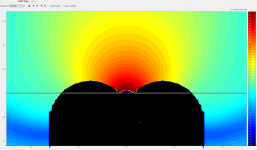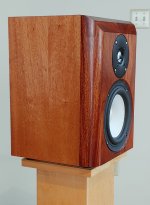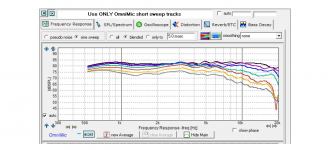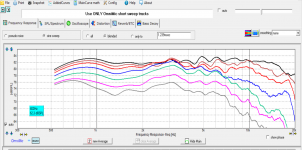
Here's an animated gif of the radiation of the tweeter and baffle from post sixteen. This covers 1000Hz to 1500Hz in ten steps.
In particular, note how the wavefront shape varies quite a bit. At some frequencies it's convex, in some it's flat, in others it's concave.
It's a complex problem, looks like it really needs to be solved in 3D.
One more thing: is it possible the 40 cm baffle is actually 40 cm from centre to each side? In other words, 80 cm wide in total?
Here's an animated gif of the radiation of the tweeter and baffle from post sixteen. This covers 1000Hz to 1500Hz in ten steps.
In particular, note how the wavefront shape varies quite a bit. At some frequencies it's convex, in some it's flat, in others it's concave.
It's a complex problem, looks like it really needs to be solved in 3D.
Hmm. The deep nulls at the sides seem to be focused on sharp edges I hadn't seen before. From here it looks like the front panel has a waveguide rounded over to almost full-space, then the front comes in a bit to 30ish degree angles before coming to sharp edges and falling abruptly into full-space again. If the sim is indeed running that profile, then the discontinuities might have a bearing on your problem.
Might the design tool be quantizing the height dimensions (dz) to the nearest millimetre?
Last edited:
Here's a close up of the Revel Salon - style model, with a 14" wide baffle with a huge roundover.
There's some aliasing artifacts up close, but that's fairly normal for Axidriver.
I am using a mesh frequency of 30,000Hz, which should be quite a bit more than necessary.
I think the Axidriver sims are relatively accurate, but they're exaggerated. For instance, the actual Revel Salon exhibits a treble curve that's relatively ragged, compared to a tweeter on a wide and flat baffle.
There's some aliasing artifacts up close, but that's fairly normal for Axidriver.
I am using a mesh frequency of 30,000Hz, which should be quite a bit more than necessary.
I think the Axidriver sims are relatively accurate, but they're exaggerated. For instance, the actual Revel Salon exhibits a treble curve that's relatively ragged, compared to a tweeter on a wide and flat baffle.
Attachments
I agree that more thought can be put to thinking about how to integrate waveguide and enclosure. I think an example of what can be achieved by integrating both in a synergistic way is in the Genelec coaxials. The 8341A is 9.3 x 13.8 x 9.6" according to their specs. But the entire front baffle of the speaker is the waveguide for their fancy surround-less coaxial. Dual woofers are slot-loaded and low-passed. The output is shaped such that directivity control is to an incredibly low frequency for the size: 500Hz baffle step based on the horizontal polars from Amir's Klippel. The DI even shows a bit of control down to 200Hz, way below one would expect for a standmount that size.
Patrick - I like your concept of considering the entire cabinet as a kind of waveguide. It may not help me from a numerical or computational standpoint, but from a conceptual standpoint, it can lead me to a better end product.
In several posts above you have said that your simulations may exaggerate the diffraction effects. I agree.
Below is a photo of a speaker I built. It uses the SB26CDC tweeter (almost identical to the SB26ADC driver of your simulations). The baffle is narrow; 10 inches total width, and 7 inches of flat baffle to the start of the roundover. The left/right roundovers have a radius of 1.5 inch (37 mm), and the bevel along the top is 30 degree, then 60 degree.
Attached is the response at 0, 15, 30, 45, 60, 75, and 90 degrees horizontal. No smoothing was applied. My measured response is quite a bit smoother than any of the simulation plots you have shown. And I realize my system does not use a waveguide on the tweeter, so the comparisons only go so far. I suspect a simulation of my system may show a worse response than what was measured.
j.
In several posts above you have said that your simulations may exaggerate the diffraction effects. I agree.
Below is a photo of a speaker I built. It uses the SB26CDC tweeter (almost identical to the SB26ADC driver of your simulations). The baffle is narrow; 10 inches total width, and 7 inches of flat baffle to the start of the roundover. The left/right roundovers have a radius of 1.5 inch (37 mm), and the bevel along the top is 30 degree, then 60 degree.
Attached is the response at 0, 15, 30, 45, 60, 75, and 90 degrees horizontal. No smoothing was applied. My measured response is quite a bit smoother than any of the simulation plots you have shown. And I realize my system does not use a waveguide on the tweeter, so the comparisons only go so far. I suspect a simulation of my system may show a worse response than what was measured.
j.
Attachments
Jim,
Does the face plate tilt downward ? Is that because you have a raising lobbying due to the filter slope of the phase ?
Does the face plate tilt downward ? Is that because you have a raising lobbying due to the filter slope of the phase ?
We use a similar effect in brass musical instruments. Adding a flat "ring" to a trumpet bell helps it launch lower frequencies better (more fundamentals and lower overtones) BUT makes it harder to play up higher. THis effect also causes a pronounced "honk" for that octave extended response - OK in the hands of a skilled artisan.
Analog, I would maintain that the flat baffles, while extending low end response, actually motivates the designer to flood the waveguide/horn with frequencies too low for it - increasing bad sounding honk. We know that horns are best used as decade devices, but that few designers are willing to accept the design limitations of at least 4 way speakers.
In the proper decade of the horn response, directivity is just fine. Why do we need to consider directivity where we should not be using the horn at all?
I agree that horns do react to the environment around them - including large TV screens 1 meter behind them.
Analog, I would maintain that the flat baffles, while extending low end response, actually motivates the designer to flood the waveguide/horn with frequencies too low for it - increasing bad sounding honk. We know that horns are best used as decade devices, but that few designers are willing to accept the design limitations of at least 4 way speakers.
In the proper decade of the horn response, directivity is just fine. Why do we need to consider directivity where we should not be using the horn at all?
I agree that horns do react to the environment around them - including large TV screens 1 meter behind them.
No it is just the odd camera angle that makes it look that way. This is a straightforward right angle box... with generously bevelled edges.Does the face plate tilt downward
Patrick - I like your concept of considering the entire cabinet as a kind of waveguide. It may not help me from a numerical or computational standpoint, but from a conceptual standpoint, it can lead me to a better end product.
In several posts above you have said that your simulations may exaggerate the diffraction effects. I agree.
Below is a photo of a speaker I built. It uses the SB26CDC tweeter (almost identical to the SB26ADC driver of your simulations). The baffle is narrow; 10 inches total width, and 7 inches of flat baffle to the start of the roundover. The left/right roundovers have a radius of 1.5 inch (37 mm), and the bevel along the top is 30 degree, then 60 degree.
Attached is the response at 0, 15, 30, 45, 60, 75, and 90 degrees horizontal. No smoothing was applied. My measured response is quite a bit smoother than any of the simulation plots you have shown. And I realize my system does not use a waveguide on the tweeter, so the comparisons only go so far. I suspect a simulation of my system may show a worse response than what was measured.
j.
It would be good to see your measurements from 1m distance at least, no smoothing (gated is fine as long as gate is larger than 3.3ms) and vertical dB range 60-90dB.
This measurement is so squished that one can not draw any conclusions out of it.
Last edited:
I agree that more thought can be put to thinking about how to integrate waveguide and enclosure. I think an example of what can be achieved by integrating both in a synergistic way is in the Genelec coaxials.
[...]
That is a clever design. Thanks for the links!
It would be good to see your measurements from 1m distance at least, no smoothing (gated is fine as long as gate is larger than 3.3ms) and vertical dB range 60-90dB. ... This measurement is so squished that one can not draw any conclusions out of it.
I did not re-measure it, but I replotted the July 19 2020 data with 2 dB vertical divisions. The measurements were taken at a distance of more than 2x baffle width. According to my notes a distance of 23 inches (58 cm). Time window gating was 4.7 ms.
Attachments
Last edited:
If there is a need for deep diving into commercial offerings and spinorama data. This will keep one occupied for a while: A collection of loudspeakers measurements
hifijim's measurement is obviously of a 2-way speaker's response, as well as Patrick's pics are of 2-3 way speakers,
but Patricks sims are of a single radiator!
but Patricks sims are of a single radiator!
Last edited:
Actually my measurements are an active 3 way. 12 inch woofer, 6 inch mid, 1 inch dome tweeter... crossovers at 200 and 2k 4th order. Although that fact does not dispute the point you are making.
This thread reminded me of Joseph Crowe's enclosures that continue an exponential horn/waveguide around a generous baffle roundover. Probably the simplest way to integrate some of the thinking in this thread, we can't all have cast alloy enclosures and custom surrounds like genelec.
Stand Mount Series 1159 -- Horn Loaded 2-way Using SB Acoustic Drivers - YouTube
Stand Mount Series 1159 -- Horn Loaded 2-way Using SB Acoustic Drivers - YouTube
This thread reminded me of Joseph Crowe's enclosures that continue an exponential horn/waveguide around a generous baffle roundover. Probably the simplest way to integrate some of the thinking in this thread, we can't all have cast alloy enclosures and custom surrounds like genelec.
Stand Mount Series 1159 -- Horn Loaded 2-way Using SB Acoustic Drivers - YouTube
I agree with this.
Here's an idea I've been tinkering with:
An externally hosted image should be here but it was not working when we last tested it.
The Infinity IL10s are my reference right now. They replaced the Yamaha DXR12 in my living room. The IL10s measure really REALLY well, but I agree with audiosciencereview, the tweeter kinda sucks. It just sounds grungy.

Revel M106 is a similar design. But it's $2000 a pair.
So it occurred to me, you might be able to make a speaker that's a combination of both. Basically buy the drivers for the M106, and put them in the Infinity cabinet.
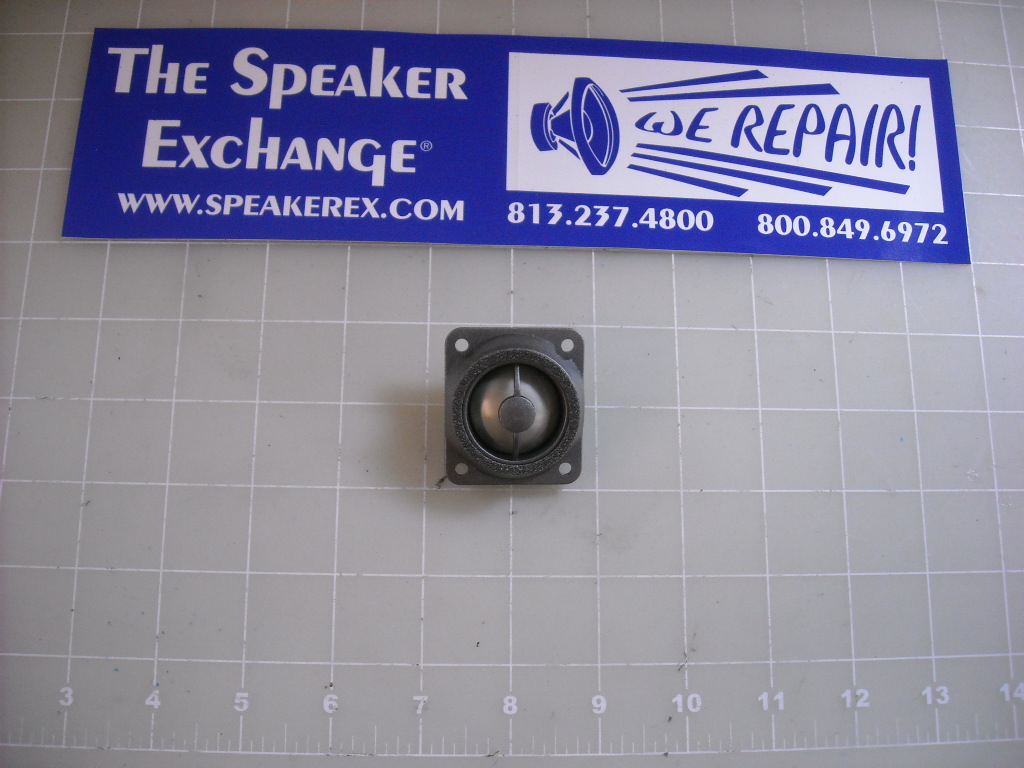
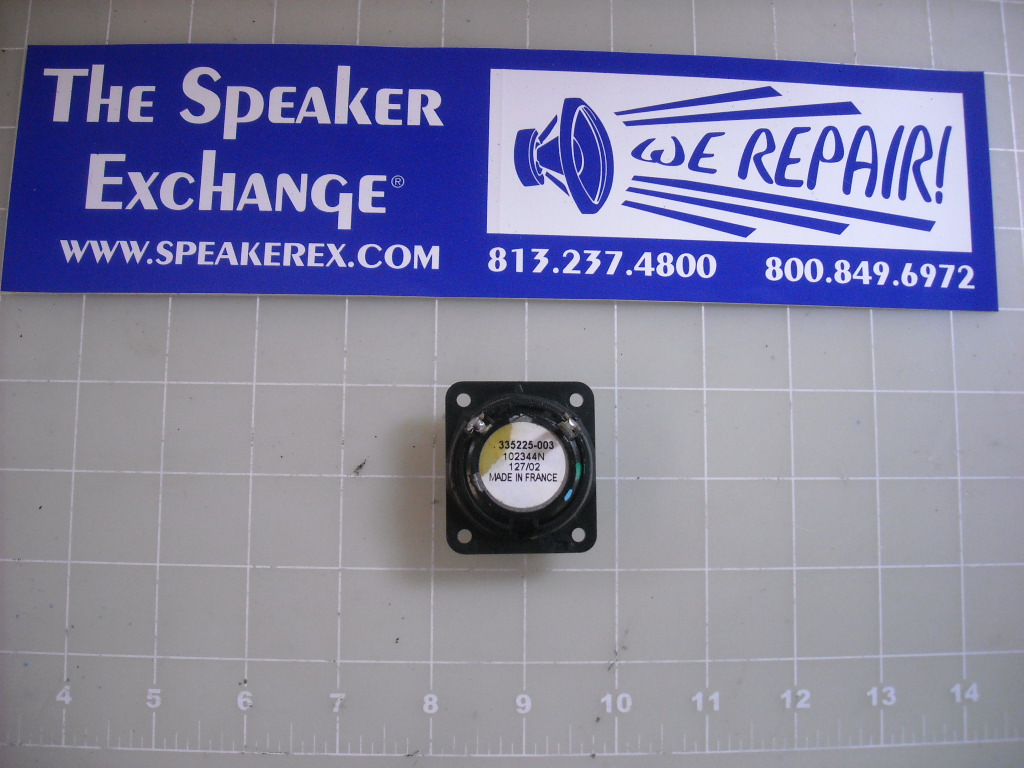
Here's the Infinity tweeter. Seems to be an Audax unit. Nothing special here; perhaps the grungy sound is due to the back chamber being so ridiculously small. This may have been a cost cutting decision to simplify the crossover.
Either way, the SB Acoustics SB26ADC is a much nicer unit. So perhaps it may be possible to take advantage of the nice quality of the Infinity cabinet, while utilizing the Revel drivers.
Here's a pic of the Infinity speakers, with the stock baffle removed. To give you an idea of how you can use the stock speaker but with a different waveguide, tweeter, and woofer. Basically 3D print a new baffle to replace the old one.
These Infinity speakers are ubiquitous on eBay and Craigslist, and can easily be found for $200-$300 a pair. Admittedly you can get a flat pack cabinet from Parts Express for less than that, but I like the diffraction reducing baffle of the Infinity.
These Infinity speakers are ubiquitous on eBay and Craigslist, and can easily be found for $200-$300 a pair. Admittedly you can get a flat pack cabinet from Parts Express for less than that, but I like the diffraction reducing baffle of the Infinity.
Attachments
As noted earlier in the thread, I felt like I hit a wall, as far as what can be simmed with Axidriver.
So I used ATH and ABEC to make some waveguides with a significant roundover.




To me, the most interesting thing about the sims is that they seem to indicate that a roundover significantly widens the beamwidth. Without a roundover, this waveguide would likely have a beamwidth of around 80-90 degrees, but WITH the roundover it's around 90-100 degrees.
So I used ATH and ABEC to make some waveguides with a significant roundover.




To me, the most interesting thing about the sims is that they seem to indicate that a roundover significantly widens the beamwidth. Without a roundover, this waveguide would likely have a beamwidth of around 80-90 degrees, but WITH the roundover it's around 90-100 degrees.
- Home
- Loudspeakers
- Multi-Way
- Loudspeaker Enclosures are Waveguides
